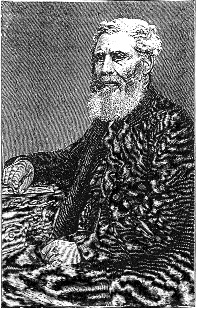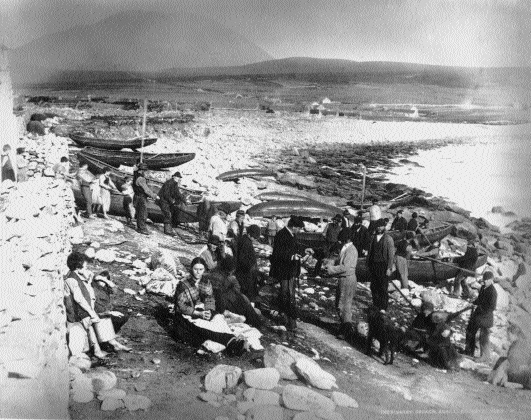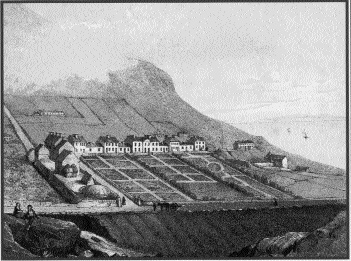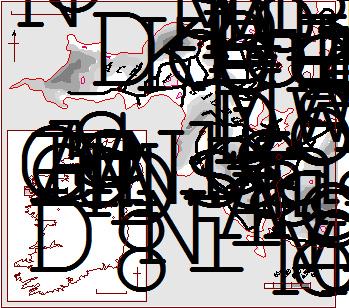Edward Nangle & the Achill Island Mission
Published in 18th-19th Century Social Perspectives, 18th–19th - Century History, Features, Issue 3 (Autumn 2000), Volume 8
Revd. Edward Nangle (1800-1883)
The first half of the nineteenth century saw a final surge in Protestant missionary activity in Ireland. This was largely a reaction to the sense of crisis in Protestant circles following both the Act of Union of 1800, and the attainment of Catholic Emancipation in 1829. There was a strong belief amongst evangelical Protestants that
If the Catholic Irish could be brought over to the Protestant faith, then the problems which bedevilled Irish society, such as economic backwardness, lack of respect for the law, and hatred of the Protestant establishment, would be eradicated.
(Irene Whelan, ‘The Stigma
of Souperism’.)
The two most influential evangelising Protestants were the Revd. Alexander Dallas from England, who was a ‘pre-millennialist’, he believed that the Bible was a historical and prophetic document which accurately predicted the events of human society in coded form; and Revd. Power le Poer Trench, Archbishop of Tuam, who was the main engine behind the evangelisation of the West of Ireland.
Nangle’s background
It was in this context that Edward Nangle enters the scene. Born in Dublin in 1800, he was descended from the powerful and influential Nangle family, who had held the title of Barons of Navan for over 600 years, up until the eighteenth century. Edward Nangle’s zeal and determination was probably due to the fact that he was the first Protestant in the Nangle line, and so he felt that he carried a great burden of responsibility. He started his ministry as curate of Athboy, County Meath, but the missionary fever soon took hold of him. In the 1820s, Nangle underwent a massive personal and spiritual crisis which culminated in what may have been a nervous breakdown. Nangle’s complex personality is well described by his biographer Revd. Henry Seddal: ‘Mr Nangle was doubtless at times headstrong in forming his opinions, stubborn in holding them, and harsh in giving them expression’. The two great driving forces in his life were Christ and the Bible, but he was also a fine painter and musician. In 1831 Nangle’s restless search for a way to fulfil God’s will took him to the remote island of Achill, Count Mayo. He sailed there on the relief ship Nottingham in response to one of the many famines that hit the West of Ireland in those times. Nangle was so struck by the desolate beauty of the island and by the primitive but noble ‘savagery’ of the people, that he decided to found a Protestant colony there with the aim of bringing Christ and the Bible to this forgotten part of Ireland. This colony, along with the one founded in Dingle, were the two most significant attempts at proselytising the West that occurred during the nineteenth century.
Foundation and consolidation
The land on which the Achill colony was built was leased from the island’s landlord, Sir Richard O’Donnell, and was located near the village of Dugort, under the shadow of Achill’s highest mountain, Slieve Mór. Edward Nangle moved permanently to the completed colony in 1834, along with his wife Eliza, his family, and his most loyal supporters. The missionary settlement consisted of male and female schools, the minister’s house, a church, a hotel, and a printing press. The lay-out of the mission, with its finely cultivated gardens, was meant to represent a civilising force in contrast to the neglected wildness of the island itself. The colony aimed to become self-sufficient, but in fact it always relied largely on subscriptions from Protestants in Ireland and abroad. One very significant fact was that the mission preached to, and taught the Achill islanders in their native tongue, Irish, and Nangle himself learned Irish so that he could communicate directly with the people. The mission’s principal instrument of dissemination was The Achill Missionary Herald and Western Witness, published continuously every month from 1837 to 1868, when it merged with other missionary publications. Nangle edited and contributed to the Achill Herald throughout its existence, and it remains as a comprehensive and fascinating document of its times, and of the system of belief on which evangelical Protestantism was based. The Achill Herald was also the means by which the colony communicated with the Protestant world in Ireland and abroad, and the main instrument of fund-raising for the colony. As well as the Herald, the Achill printing press also turned out many volumes on Protestant doctrine, revelation, and even an Irish language dictionary.
Relations between the mission staff, which included scripture readers, teachers and doctors, and the native islanders, were good at first, and the people seemed to be open to the ideas and beliefs of the missionaries. Nangle had always believed that the island was basically pagan and that the people practised idolatry rather than any formal brand of Christianity.

Dooagh, Achill, c. 1885. (Sean Sexton)
‘Venomous fanatics’
The Catholic church was soon reminded of its neglect of the West of Ireland, and the early successes of the mission spurred it into action. The turning point came in 1837 when the Catholic Archbishop of Tuam, John McHale, visited the Island and stirred up the populace against what he called ‘these venomous fanatics’. The Achill Herald recounts an incident during McHale’s visit to neighbouring Clare Island when a scripture reader and a schoolmaster from the mission were beaten and pursued ‘almost to the death’ by the locals, and had to flee the island by night to save their lives. The arrival of Father John Dwyer, appointed by John McHale, as parish priest of Achill, heralded a sustained attack on the colony, its staff and supporters. Caesar Otway’s biased but evocative description of these early attacks on the mission give us a feel for the passions aroused on both sides. In A Tour in Connaught (1839), he relates a sermon preached against the mission by Fr Dwyer:
But the priests did not stop here, and their commands were, ‘Have nothing to do with these heretics—curse them, hoot at them, spit in their faces—cut the sign of the cross in the air when you meet them, as you would against devils—throw stones at them—pitch them, when you have opportunity, into the bog holes—nay more than that, do injury to yourselves in order to injure them—don’t work for them, though they pay in ready money—nay, don’t take any medicine from their heretic doctor [Neason Adams], rather die first’.
In the first few years of its existence the colony’s staff and supporters suffered a constant rain of abuse, beatings, and humiliations at the hands of hostile islanders. All these incidents are exhaustively related in the Achill Herald, which made maximum use of their propaganda value. But the attacks, far from discouraging Nangle, just spurred him on to greater defiance. He revelled in the martyrdom bestowed on him and his colony. In a letter of support to Nangle, the Revd. William Cleaver expressed the embattled philosophy of the Protestant crusade in the West: ‘A battle may be fought in Achill the effects of which may be felt throughout Ireland. The Lord be with his little army then’. Nangle’s unflinching belief in the rightness of his cause was matched by the equal but opposite determination of Archbishop John McHale to destroy the colony—’There is no place outside of hell which more enrages the Almighty than the Protestant colony’. However, the bitter defiance and rigid dogmatism of Edward Nangle was balanced by the genuine altruism and idealism of Nangle’s friend and fellow missionary Dr Neason Adams. Dr Adams had given up a lucrative medical practice in Dublin to join Nangle and to tend to the sick and poor of Achill for over twenty years without pay. Both Dr Adams, known as the ‘St Luke’ of Achill, and his wife Isabella, were admired and respected by all factions on the island, because their genuine humanity and idealism were never in doubt. By the late 1830s and early 1840s the missionary colony was well established and was becoming famous throughout Ireland and England, even if its success at actual conversions was limited. Famous visitors to the colony at this time included Sir John Franklin, who greatly admired Nangle, and who stayed in Achill shortly before his ill-fated voyage to find the North-West passage, also the travel writers Mr and Mrs S.C. Hall, who stayed briefly at the colony, and afterwards enraged Nangle by writing very critically of the mission and its methods in their book Ireland, Its Scenery and Character (1842).
The Great Famine: God’s judgement
The Great Famine of 1845-49 hit Achill Island particularly hard because, given the poor quality of the soil, there was little or no alternative to the potato crop which failed throughout these years. The Great Famine was only the worst of a series of famines that Achill endured in the first half of the nineteenth century, but it still came as a surprise and an unprecedented challenge to Edward Nangle and the colony. Characteristically this motivated Nangle like never before, and proved to be the true test of the staying power of both him and his mission. Nangle was in no doubt as to the causes of the Great Famine. As a pre-millenialist he looked no further than the Bible for the logical cause of the pestilence. The famine was God’s judgement for Ireland’s sins which Nangle classified under three headings: ‘unatoned-for blood; idolatry in the professing people of God, especially when sanctioned by the rulers of the country; profane neglect of the house and ordinance of God’. Specifically Nangle believed the famine happened because the British government had sponsored and supported the Catholic seminary at Maynooth: ‘It [the endowment of Maynooth] is done, and in that very year, that very month, the land is smitten, the earth is blighted, famine begins, and is followed by plague, pestilence, blood!’ The concept of prophesy fulfilled was central to Nangle’s system of belief, so he had no problem in coming to terms with the moral implications of the famine. In the 1840s Nangle published A Short and Simple Explanation of the Book of Revelation of Jesus Christ. In the preface Nangle wrote:
Those faithful servants of Christ, both in our own country and throughout the continent, were unanimous in the persuasion that popery was the great foretold apostasy; that Daniel’s prophesy of the Little Horn (Dan viii) and St Paul’s prophesy of the Man of Sin (2 Thess. ii) pointed directly to the Pope.

Lithograph of the mission settlement, Dugort, 1845. (John O’Shea)
Throughout his long life Nangle never wavered in his utter detestation of Roman Catholicism, and in his belief that the pope was Antichrist. Yet Nangle’s hatred was ideological, not personal, and while he hated the institutions of the Catholic church, he often showed great compassion and concern towards ordinary Catholics themselves. The fact is that Edward Nangle and the Protestant colony helped Achill in a very practical way, despite all the lofty rhetoric and self-righteousness. By the spring of 1847 Nangle reported that the colony was giving employment to 2,192 labourers and feeding 600 children a day in the schools. When the Protestant Archbishop of Tuam, Thomas Plunket, visited Achill in the autumn of 1848, there were over 2,000 children attending the mission schools. A year later he confirmed 400 children in the presence of an immense congregation. But Nangle initially distributed aid to the starving of Achill in accordance with strict principles. The aim of the mission was to convert the inhabitants to the Protestant faith, so pressure was put on the recipients of food aid and work to convert. This earned Nangle the derogatory labels of ‘souper’ and ‘Black Protestant’, but the truth was more complex. As the situation grew more desperate, and the island became totally reliant on the colony for relief, Nangle abandoned the principle of food for conversion, and distributed aid freely. However, he stipulated that the able-bodied must work for relief, and that only one member of each family could work at the colony.

In 1848 there were more than 3,000 people working for the mission, clearing land, building roads and walls, etc.. In July 1847 it was estimated that out of Achill’s total population of 7,000, 5,000 were receiving daily relief from the mission. The mission also planted twenty-one tons of blight-free foreign potatoes. The colony was now the recognised centre for food distribution on the island. In November 1848, the barque William Kennedy, freighted with 220 tons of Indian meal, arrived in Achill from Philadelphia. It had enough supplies to feed 2,000 people and cost £2,200 paid for out of mission funds. There can be little doubt that Nangle and his mission saved Achill during the famine, and that without them thousands would probably have starved. Hopes were expressed that Achill might soon become a Protestant island. This was the zenith of the mission’s fortunes. According to Theresa McDonald:
[In 1849] Divine service was now being celebrated in Dugort, Mweelin, Achill Sound and Bullsmouth, and plans were advanced to open another station for preaching the gospel in Duagh (Dooagh). Eight Protestant clergymen were employed in Achill, five churches had been constructed, another was in progress, and there were five stations where divine service was celebrated.
Decline
In 1850 the Achill mission purchased three-fifths of the island from the O’Donnell estate in the encumbered estates court. The mission was now effectively the landlord of Achill, responsible for collecting rents. In a move that was to prove ominous the remaining land was purchased by Archbishop John McHale and his nephew William McCormack. The Catholic ‘counter reformation’ had begun in earnest and this time McHale had come with a papal interdict to finish off the mission once and for all. John McHale was very much the adversary of Edward Nangle in the drama of the Achill mission but there were some remarkable similarities in their personalities and circumstances. Both started their respective ministries in 1834, McHale in Tuam and Nangle in Achill, and both were utterly single-minded in pursuit of their ideals. Like Nangle McHale also had a strong liking for the arts, being a lyric poet and translator of Homer’s lliad into Irish. The early 1850s saw the start of a relentless onslaught by the Catholic Church against the mission, including altar denunciations, boycotts, and the forcible removal of children from mission schools. The unkindest cut of all though, came with the foundation of a Franciscan monastery in the Achill townland of Bunacurry. An enraged Nangle reacted by calling on the Orange Order in Belfast to come to his aid, ‘we will call them to our aid in this spiritual warfare—they have what we need, organisation, determination, and zeal’.
But it wasn’t just the Catholic church that was turning the tide against the mission. In 1852 Edward Nangle left Achill to become the rector of Skreen, County Sligo. Though he continued to spend three months a year in Achill and was still very active as the actual head of the mission, it soon became clear that the colony was suffering from his prolonged absence. The state also played its part in the mission’s downfall as successive land acts undermined its power as Achill’s landlord, and the land wars of the 1870s and ‘80s wrought very unfavourable changes for the mission. The colony was also beginning to implode under pressure of internal strife. From the early 1860s Edward Nangle began a long drawn out legal battle with Joseph Napier, one of the trustees of the Achill mission committee. The case started as a minor disagreement over the election of committee members, but it escalated into a major court case that dragged on for years, draining the resources of the Achill estate. Nangle eventually won the case, but it was a pyrrhic victory, as the mission was now broke. Not for the first time in his life, Nangle’s wounded pride and rashness, so important in driving him on against the odds, also drove him blindly to his own destruction.
Nangle’s legacy
By the 1880s the Achill mission colony was dead in all but name, having submitted to the overwhelming forces ranged against it. But even to this day the colony’s buildings and church stand as a legacy to that struggle. The demise of the mission was a cause of great sorrow to its founder Edward Nangle, who died largely forgotten in 1883. For over fifty years Nangle had given his all to the mission, and not just in sweat and ink. During his Achill struggles he buried his first wife and no less than ten of his children, who died in childbirth or in childhood, and innumerable more of his friends and supporters. More than a century on, the legacy of Edward Nangle and the Achill Island mission should not be seen in terms of success or failure at conversions, but in terms of what it did for Achill Island. We have already mentioned the thousands saved from starvation during the Famine. But the legacy of the mission can also be seen in the modernisation of the island which it started, and which accounts for the schools, churches, roads, piers, and even the Catholic church itself! There is no doubt that Edward Nangle caused controversy and strife on the island, and that his methods were often questionable. But the good he did should be equally obvious. In 1831, shortly after his decision to found a colony in Achill, Nangle was confronted by a Church of Ireland minister on a street in Dublin who predicted that ‘the priests would blow the mission off the island in six weeks’. And so they did, but it took considerably longer!
Niall R. Branach is a history graduate of Trinity College, Dublin, currently working on a historical novel on Edward Nangle and the Achill mission.
Further reading:
H. Seddall, Edward Nangle: The Apostle of Achill (Dublin 1884).
T. McDonald, Achill Island: Archaeology, History, Folklore (Dublin 1997).
P.J. Joyce, A Forgotten Part of Ireland (Philidelphia 1910).
















